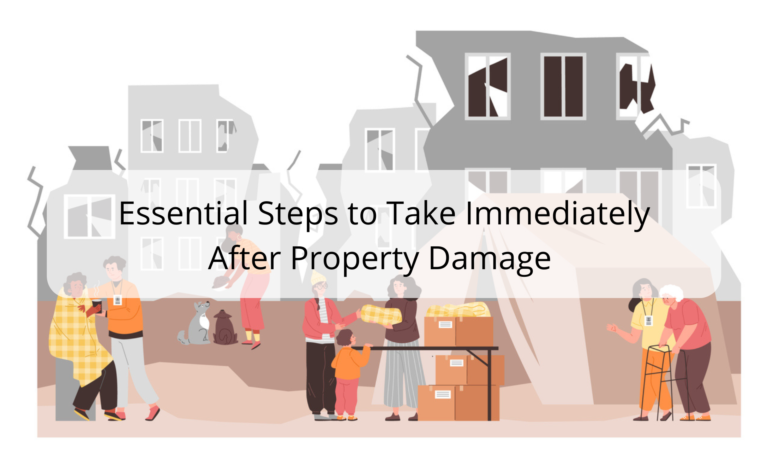Experiencing property damage, whether from a storm, fire, flood, or other disaster, can be overwhelming and stressful. Taking the right actions immediately after the incident can make a significant difference in the outcome of your insurance claim and protect your property from further harm. Here’s a step-by-step guide to help you stay focused and proactive during a challenging time.
Step 1: Prioritize Safety
Before assessing the damage, make sure it’s safe for you and others to enter the property. Structural instability, live wires, water damage, or gas leaks can pose serious hazards, so it’s essential to be cautious.
– If there are signs of structural damage: Avoid entering the property until it has been inspected by a professional.
– For potential electrical hazards: Turn off the main power if it’s safe to do so, or call a professional to handle it.
– In case of water damage: Avoid standing water as it may be contaminated or electrically charged.
Step 2: Secure the Property
Once safety is ensured, take steps to secure the property and prevent further damage or unauthorized access. Insurance policies typically require property owners to mitigate additional damage, so acting quickly here can help prevent claim issues later.
– Board up broken windows and doors to keep out the elements and prevent potential break-ins.
– Place tarps over roof damage to keep out rain and prevent water damage.
– If necessary, hire security or temporary fencing for large properties to deter vandalism or unauthorized entry.
Step 3: Document the Damage
Documentation is one of the most crucial steps in the claims process. The more detailed your documentation, the easier it will be to file and support your claim with the insurance company.
– Take photos and videos of every damaged area, including close-up and wide-angle shots.
– List all damaged items with approximate values. Include details like brand, model, and purchase date if possible.
– Make a note of any structural issues, such as cracks, holes, or collapsed areas.
– If items need to be moved for safety reasons, take photos of them in their original location first.
Step 4: Contact Your Insurance Company
Reporting the incident to your insurance company as soon as possible is essential. Many policies have strict timelines for filing claims, so prompt notification is key to staying in compliance.
– Have your policy number ready and be prepared to provide a brief overview of the damage.
– Ask if there are specific forms or documents they require initially and if an adjuster will be assigned to your claim.
– Document all conversations by noting the date, time, and the name of the representative you spoke with.
Step 5: Prevent Further Damage
In addition to securing the property, take any necessary measures to prevent further damage. Insurers typically require “reasonable” action to protect the property from worsening conditions.
– Remove standing water (if safe) and set up fans to begin drying out affected areas.
– Clear any debris or hazards that could worsen damage, like broken glass or sharp objects.
– Save receipts for any expenses incurred, such as temporary repairs, tarps, or materials to secure the property. These costs may be reimbursed by your insurance company.
Step 6: Begin a Claim Folder for Organization
The claims process can involve a lot of paperwork and follow-up, so staying organized is crucial for managing the process effectively.
– Create a digital or physical folder to store all relevant documents, receipts, and communication logs.
– Keep copies of all claim forms, repair estimates, and photos of the damage.
– Include a log of communications with your insurer, adjusters, and contractors to keep track of the claim’s progress.
What to Remember in a High-Stress Situation
When dealing with property damage, emotions can run high, and it’s easy to feel overwhelmed. Here’s a quick recap to help keep you on track:
– Prioritize safety—don’t enter unsafe areas or attempt repairs without caution.
– Secure your property to prevent further damage or unauthorized entry.
– Document everything—take photos, videos, and notes of all damaged areas and items.
– Notify your insurance company promptly and ask what documents are needed for your claim.
– Prevent further damage—take reasonable measures to protect your property while saving receipts for temporary repairs.
– Stay organized by creating a claim folder to track paperwork, receipts, and conversations.
Taking these steps promptly and carefully can help protect your property, support your claim, and provide peace of mind during a challenging time.
D.A. Lamont Public Adjusters: Here to Support You
Navigating the aftermath of property damage can be overwhelming, but you don’t have to face it alone. At D.A. Lamont Public Adjusters, we understand the intricacies of insurance claims and are here to guide you through each step, from documenting the damage to negotiating a fair settlement. Our team is dedicated to advocating for your best interests, ensuring you receive the compensation you need to rebuild and recover.
If you’re facing property damage and need assistance with the claims process, contact D.A. Lamont Public Adjusters today. We’re here to help you rebuild with confidence and peace of mind.


